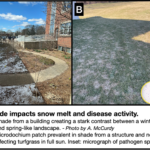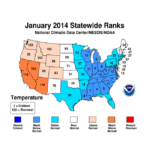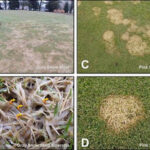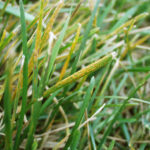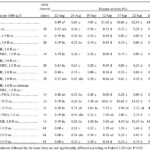Category: Disease Control
A Cold Mold that Craves the Shade
Pink snow mold is a disease caused by the fungal pathogen Microdochium nivale (syn. Monographella nivalis) that is being observed in middle and northern Indiana this late winter. The pathogen is termed psychrophilic, or cold loving, due to its propensity to grow and infect in colder temperatures. The disease can be particularly severe on unfrozen […]
Look Below Before Blaming Above
Recently, home lawns have been maligned in several media outlets as a waste of time and resources. Mismanagement by using too much water or misplacing fertilizer may compound the issue by straining environmental resources or serving as pollutants. While not going into all the defenses for turfgrass use on home lawns, (remember “right plant, right […]
Lawn Diseases 2016
The summer of 2016 has been quite favorable for the development of an assortment of infectious diseases on residential turf. The primary driver of all of this disease activity is the weather. In the lower Midwest, the combination of elevated temperature and ample precipitation since the beginning August of has spawned outbreaks of brown patch, […]
More fungicide applications for snow mold control?
Over the past two weeks I received many calls regarding the mild conditions and concerns about effectiveness of fungicide applications for snow mold control. The major question is whether or not to make another application at this time. Consider he following: The snow mold of concern here in Indiana is pink snow mold, aka Micodochium […]
Winterkill Here on Bermudagrass! Now What?
This winter has resulted in significant winterkill on bermudagrass throughout the nation and Indiana was not an exception. Brutally cold temperatures, coined as the polar vortex, swept through the country in early January with many other subsequent cold days and nights to follow. The below link summarizes the damage that I have observed this spring, […]
Cool-Season Turf Winterkill: Potential Losses and a Pathway to Recovery
This winter has been cold and long. From December 2013 through February 2014, Indiana had it’s 9th coldest winter on record and its coldest since 1979, 1978 was coldest on record (Fig. 1). With such cold temperatures, many are worried about winterkill. Fig. 1. In the past 120 years, this was the 9th coldest […]
Warm-season Turf Winterkill 2014: What Can you Expect and NOW WHAT?
With colder than normal temperatures in Indiana this winter, we are anticipating some minor winter damage. To help prepare for this we are publishing a three part series on this topic to help turfgrass managers prepare for what may await them in the spring. Look forward to the following topics over the next week. Part […]
Snow Molds in the Winter of 2013-14
From a turf disease perspective, evidence of the severity of this winter is apparent in the extent of snow mold development. Symptoms of Typhula snow molds (gray snow mold and speckled snow mold), and/or pink snow mold are obvious throughout Indiana and the Midwest. Typhula snow mold pathogens are adapted to grow and infect at […]
Rust Disease – 2013
The 2013 rust disease outbreak seems to have arrived a little earlier than usual. My thoughts about the current rust epidemic are intended for lawn care professionals, who must address reasonable questions from their clients. Most professionals are very familiar with the basics of rust disease. To briefly review from the 2013 perspective–the ample precipitation […]
Spring Diseases in the Midwest
Spring has finally arrived and it is accompanied by the usual compliment of infectious turf diseases. There should be no confusion between two “rhizoctonia” diseases. Yellow patch (aka cool season brown patch) prevails during early spring, when rainy weather is combined with cool nights. It also affects al turf species and the circular patches are […]
Weather and Turf Diseases
From a temperature perspective, weather patterns in the Midwest have returned to normal this spring. I recall the 80 F days in March 2012, and all of the concerns about scheduling fungicide sprays. Hopefully most turf managers have resisted the temptation (regardless of who or what is doing the tempting) to apply fungicides for early […]
Weather and Turf Disease –Early Spring 2013
Nobody needs to be reminded that March 2013 has been colder than the last several years. The good thing is that wintry conditions prevent wasted fungicide applications. Keep watching the summer patch soil temperature monitor. Remember that there are several elements to the decision rule. The cardinal temperature seems to be around 65F—in soil at […]
Turf Notes: Disease and Fungicide Update
Early Season Dollar Spot Sprays The pathogen must be active in order for the mycelium to absorb a fungicide. We know that Sclerotinia homoeocarpa grows when temperatures remain above 55F in the presence of ample moisture. If such conditions prevail in March (as they did in 2012), then early season sprays may help reduce dollar […]
Gray Leaf Spot
Recent weather (remnants of hurricane Isaac) raised concerns about gray leaf spot in the Ohio Valley and the lower Midwest in general. You may recall that the pathogen does not overwinter efficiently in the Midwest, and inoculum (airborne spores) from storms that originate in the South is significant. Gray leaf spot is a foliar disease […]
Snow mold damage – 2011
Melting snows revealed some significant snow mold damage. As you know there are two types of snow mold diseases, gray snow mold (aka Typhula blight) and pink snow mold (Microdochium patch). Although they create similar symptoms (circular patches of tan turf—sometimes with orange/brown margins, Fig. A, C, D) the pathogens are not closely related and […]
Top Ten Turf Tips of 2010
Part II: Summer diseases in Residential Turf Part III: Summer weeds: Common summer weeds and their control Part I: Too hot: Why some turfgrass species look poor in summer Color Variation in Residential and Commercial Lawns Crabgrass Control Now is the time to seed lawns and other turf areas Choosing a Preemergence Herbicide Late Fall […]
Rust Diseases
Rust is a disease of taller mown turf. Outbreaks are most common on residential lawns, low budget athletic fields, and, occasionally, on golf course roughs. A variety of related fungi cause rust. Ccommon names include leaf rust, crown rust, and stem rust, and the disease occurs almost exclusively on Kentucky bluegrass and perennial ryegrass. Rust […]
Summer Stress
Summer Stress With a warm and wet summer, we are experiencing decline in some of our turf around the state due to temperatures, disease, insects, and weeds. In response, we are publishing a four part series on this topic to help turfgrass managers respond. Look forward to the following topics over the next two weeks. […]
Gray Leaf Spot 2010
Gray leaf spot has been identified on perennial ryegrass fairways in northern Kentucky. It is likely that outbreaks will occur in southern Indiana with the next rainstorm (or it may already be established). If the turf that you manage has a history of the disease, this would be a good time to consider apply a […]
Slime mold
Slime mold can occur on all turf grasses. The disease does not infect the plant but instead grows on the outside of the leaves. Yellowish, purplish, or grayish fruiting bodies may be observed during wet periods. As the turf begins to dry, the structures become powdery. Since the disease is only cosmetic in nature, chemical […]
